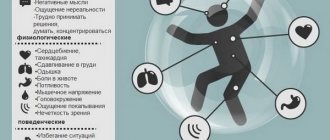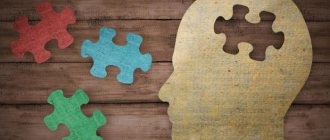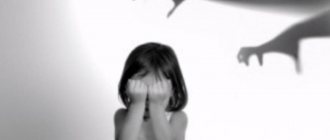The International Classification of Diseases classifies mental disorders as follows with descriptions:
- mental disorders of organic origin;
- disorders associated with the use of psychoactive substances (alcohol, drugs, toxic substances);
- schizophrenia spectrum disorders;
- affective disorders;
- neuroses;
- behavioral disorders associated with physiological and physical factors;
- personality and behavior disorders;
- mental retardation;
- violation of psychological development;
- child and adolescent mental disorders;
Mental disorders of organic origin
Types of mental disorders:
Dementia due to Alzheimer's disease.
It is characterized by a gradual decrease in cognitive abilities against the background of a progressive degenerative disease and atrophic changes in the brain. Main signs: memory impairment, personality changes, social maladjustment, inability to self-care.
Vascular dementia.
Occurs due to impaired cerebral circulation. Most often, dementia develops against the background of cerebral atherosclerosis. Develops slowly. Main signs: gradual loss of short-term memory, apathy, abulia.
Dementia in Pick's disease, Parkinson's disease, Huntington's disease, Creutzfeldt-Jakob disease.
Occurs due to organic damage to the cortex and subcortical brain structures. It is characterized by severe intellectual impairment, absent-mindedness, memory loss, and changes in personality and behavior.
Organic amnestic syndrome.
It is characterized by a pronounced decrease in short-term memory, a reduced ability to learn new information, and confabulations. Usually intelligence and personality are preserved.
Delirium.
It is characterized by impaired consciousness, disorientation, impaired thinking and memory, true hallucinations, sleep disturbances, anxiety and autonomic changes.
Symptomatic mental disorders.
This includes disorders caused by organic brain damage (stroke, traumatic brain injury, tumor).
The group of mental disorders of organic origin also includes:
- organic delusional disorder;
- organic hallucinosis;
- organic dissociative disorder;
- organic anxiety disorder;
- organic emotionally labile disorder;
- personality disorders of organic origin.
Diagnosis of mental disorders
Diagnostic criteria for mental disorders, also known as “mental illnesses,” consist of checklists of symptoms that primarily focus on a person's behavior and thoughts. These lists of symptoms have been summarized based on current diagnostic criteria commonly used by mental health professionals.
Diseases can be divided into three main categories:
· In adults,
· In children;
· Personality disorders.
Some species may fall into more than one category.
Remember that only an experienced mental health professional can make a real diagnosis.
Find out how parental quarrels in front of a child affect the child’s psyche. Why is it dangerous to sort things out in front of a baby?
Substance use disorders
This includes mental illnesses that occur after taking alcohol, opioid drugs, cannabinoids, sedatives and hypnotics, cocaine and psychostimulants, hallucinogens, tobacco and volatile solvents. This includes many syndromes and pathological conditions. Here are the main types:
Acute intoxication. Usually characterized by nausea, vomiting, impaired consciousness, disorientation, headache, and autonomic disorders.
Withdrawal syndrome. Characterized by complex mental disorders after a long break from taking psychoactive substances.
Acute psychotic disorders. Characterized by hallucinations, delusional disorders, emotional disturbances, and illness of consciousness during or after taking a psychoactive substance.
Dependency syndrome. Characterized by obsessive desires and actions to use a new dose of the drug.
Amnestic syndrome. It is characterized by severe memory impairment for distant or recent events, impaired perception of time and confabulations during or after drug use.
Treatment of disorders
Therapy for mental disorders involves a number of activities:
- psychotherapy (individual and group classes), auto-training, neurolinguistic programming;
- course of medication, depending on the cause of the disease: sedatives (Valerian, Motherwort, Afobazole, Tenoten), tranquilizers (Hydroxyzine, Buspirone and analogues); neuroleptics (Propazina, Flupenthixol), antidepressants (Befola), nootropics (Mexidol, Pantogama), mood stabilizers (Valpromide, lithium salts);
- acupuncture, massage, narzan baths;
- giving up bad habits, avoiding stress, leading a healthy lifestyle.
Schizophrenia spectrum disorders
This includes:
- Schizophrenia. Characterized by gross disturbances of thinking, emotions, will and social life.
- Schizotypal disorder. Characterized by social isolation, flatness of emotions, and inappropriate behavior.
- Chronic delirium. Includes diseases that manifest themselves only as delirium.
- Acute and transient psychoses. It manifests itself as temporary acute psychotic disorders with a predominance of delusions, hallucinations and disorders of consciousness.
- Induced delirium. It is characterized by the fact that delusion occurs in a mentally healthy person, but this delirium is inspired by the sick.
- Schizoaffective disorder. Characterized by inappropriate emotional reactions and behavior, a tendency to social isolation.
Symptoms
And with schizophrenia, and with psychosis and all other similar types of diseases, a person always has the following symptoms characterizing a psychotic disorder. They are often called “positive”, but not in the sense that they are good and useful to others. In medicine, a similar name is used in the context of the expected manifestations of a disease or a normal type of behavior in its extreme form. Positive symptoms include hallucinations, delusions, strange body movements or lack of movement (catatonic stupor), peculiar speech, and strange or primitive behavior.
Affective disorders
The most common:
- Depression. Characterized by depressed mood, low motor activity and slowed mental processes.
- Bipolar affective disorder. Characterized by alternating depressive and manic syndromes.
- Seasonal affective disorder. It manifests itself as low mood and disturbance of emotions in the autumn-spring period of the year.
How to understand that a person is mentally ill. Mentally ill people: signs, photos
We will consider treatment of patients suffering from similar ailments below.
For now, let's talk about how to understand when it comes to pathology. It is worth knowing that it is not always possible to distinguish a mentally ill subject from a healthy one. Often during the period of remission, patients seem quite adequate. Mentally ill people move freely around the city and lead a normal life. This helps them adapt to public life and does not infringe on human rights. However, some patients require constant care. Otherwise, they pose a danger to themselves and others. Such people immediately stand out in the crowd for their antisocial behavior. Some patients appear normal, but their mental abnormality can be understood when communicating with them. Therefore, it is important to know how mentally ill people differ. Signs of pathology are listed below.
- Marked antisocial behavior. These people often talk to themselves and use profanity. Their words are sometimes not connected in meaning. In some cases, they try to attract the attention of others: they shout, express aggression, and start inappropriate conversations. Most often, these people do not pose a danger to others.
- Mental retardation. Diseases accompanied by this symptom include Down syndrome and dementia. With a mild degree of pathology, patients can lead an independent life, engage in physical labor or simple mental activity. In severe cases, they are always accompanied by relatives. Patients with mental retardation are non-dangerous mentally ill people. The signs, photos and characteristics of a person suffering from this pathology are usually easy to determine in comparison with healthy subjects. The difference is not only in behavior, but also in appearance (wide bridge of the nose, small head size, flattened skull vaults, enlarged tongue).
- Disturbance in self-orientation, pronounced changes in memory. Similar pathologies include Pick's disease and Alzheimer's disease. Patients do not understand where they are, who is next to them, and confuse past events with the present time.
- Paranoid syndrome, various types of delusions. Often considered a manifestation of schizophrenia.
- Refusal to eat, reluctance to get out of bed, get dressed, etc. Such symptoms indicate an unfavorable form of schizophrenia (catatonic syndrome).
- The appearance of obsessions, depressive and manic states.
- Split personality.
Neurotic disorders
Neuroses include:
- Obsessive-compulsive disorder. Characterized by obsessive thoughts and behavioral acts.
- Anxiety disorders group. They are characterized by constant internal discomfort and tension, anxiety, and a feeling of impending disaster or failure.
- Phobias. This includes irrational fears that do not objectively threaten a person’s physical health.
- Stress-related disorders: post-traumatic stress disorder, adjustment disorders. They are characterized by the inability to adapt to changes, autonomic disorders, lack of sleep, and avoidance of conflict situations.
- Dissociative disorders. Manifested by neurological disorders: paralysis, paresis, anesthesia in parts of the body, dissociative stupor, amnesia, fugue.
- Somatoform pathologies. These are mental disorders that translate into physical symptoms. Most often - psychosomatic diseases and migrating pain throughout the body.
- Neurasthenia. It manifests itself as exhaustion, fatigue, irritability, and sleep disturbance.
Obsessive-compulsive disorder (OCD)
Another disease associated with anxiety. With it, the patient has obsessive, frightening thoughts that he is unable to fight. To get rid of anxiety, a person performs some kind of ritual: spits over his left shoulder, checks all the locks in the house, washes his hands, and so on. These actions may seem pointless, but they help the patient to relieve the condition for a short time.
A person with OCD can be recognized by the same speech characteristics as those with generalized anxiety disorder. These are complaints, suspiciousness, repeated conversations about fears. However, it will be much more effective to observe his behavior and track the ritual. A typical OCD patient is the American inventor Howard Hughes, about whose life the film “The Aviator” was filmed. He constantly washed his hands because he was afraid of catching an infection.
It is very difficult to identify patients with OCD by phrases in speech, the exception is if the person himself wants to tell you about what is bothering him. It’s not difficult to notice them if you watch people in the park, for example.
Lyutsina Lukyanova
Behavioral disorders associated with physiological characteristics and physical factors
List of pathologies:
- Eating disorders: bulimia nervosa, anorexia nervosa, psychogenic vomiting, binge eating disorder, orthorexia nervosa. The disorders are characterized by loss of control over the amount of food eaten, obsessive monitoring of body weight and external attractiveness.
- Sleep disorders of nonorganic origin: insomnia, drowsiness, sleep pattern disorders, sleepwalking, nightmares.
- Inorganic sexual disorders: decreased libido, aversion to sexual intercourse, erectile dysfunction, premature ejaculation, vaginismus, increased sexual desire. These are functional disorders: they occur after a quarrel, with emotional changes, or lack of sleep.
- Mental pathologies associated with the postpartum period. Characterized by emotional and behavioral disorders after childbirth. More often – postpartum depression.
Physiological disorder
This group includes disorders of eating, sexual activity, as well as childbirth and sleep. The problems are quite common in society, with a small percentage seeking help.
This is due to ignoring the problem; many people prefer to treat disorders using alternative medicine or simply hide the disease.
List of behavioral syndromes associated with physiology:
- Anorexia nervosa and bulimia
. The diagnosis of anorexia is made when the weight is pathologically low from the required norm. Patients not only reduce the amount of food they eat, but also take laxatives. Main symptom: distortion of body image. In bulimia, vomiting is caused to get rid of food eaten. - Sleep disorder
. Difficulties arise in maintaining sleep, the process of falling asleep and rest patterns are disrupted. - Sexual dysfunction
. It includes frigidity, increased libido, psychogenic impotence, premature ejaculation. - Disorders in the postpartum period
. An exacerbation occurs in the first weeks after childbirth; some women experience sensitivity, irritability, apathy, and lack of composure.
Personality and behavior disorders
List:
- Personality disorders: paranoid, schizoid, dissocial, emotionally unstable, hysterical, anancastic, anxious-avoidant, dependent, narcissistic, passive-aggressive.
- Personality changes that are not caused by organic brain damage. Occurs after strong experiences: a car accident, the early loss of a loved one, a serious somatic illness.
- Disorders of habits and desires. These include “manias”: pyromania, gambling, gambling addiction, homicidomania, brodomania. Characterized by an uncontrollable attraction to something: fire, murder, petty theft.
- Pathologies associated with sexual self-determination: transsexualism, transvestism.
- Disorders associated with sexual preferences: fetishism, voyeurism, pedophilia, necrophilia, bestiality, exhibitionism, masochism, sadism, sadomasochism.
Generalized anxiety disorder
Epidemiology of anxiety disorders in the 21st century affects a third of the planet's population. A person constantly experiences anxiety and anxiety, suffers from unpleasant sensations in the body: trembling, sweating, dizziness, discomfort in the solar plexus area. Anxiety is usually caused by a variety of fears related to the future.
Among the features of communication:
- Stories about your own fears. A person is afraid to either fly on a plane, or get into an elevator, or communicate, or go into unfamiliar places.
- Constant indignation and complaints, including about health conditions.
Often these are lonely people who have not achieved success in their personal lives and work. They are often outraged by something: the leadership of the country or company where they work, the situation in the state or at home - everything they encounter in life.
Lyutsina Lukyanova
Mental retardation
According to the old classification, mental retardation in children was divided as follows:
- debility;
- imbecility;
- idiocy.
The modern classification looks like this:
- mild mental retardation – 50-69 IQ;
- moderate mental retardation – from 35 to 49 IQ;
- severe mental retardation – from 20 to 34 IQ;
- deep – up to 20 IQ.
Oligophrenia is characterized by reduced or absent abstract thinking, difficulty in establishing cause-and-effect relationships, difficulties in self-care, social maladjustment, and emotional disturbances.
About consequences and prevention
The inability to clearly perceive reality, lack of control over the situation with excessive expression of emotions can lead to sad social, family and moral consequences in the form of loss of family, loved one, job, ending in suicide attempts, deep depression, and the need for long-term inpatient treatment in a psychiatric clinic.
Therefore, decisive measures are needed to prevent mental disorders in the form of measures to socialize the unsociable “locked in his shell”, instilling in children from early childhood respect for other people’s opinions, organizing “fasting” days with a break from intense mental activity, walks and active recreation nature.
If there is the slightest suspicion of a psychotic illness, an immediate consultation with a psychiatrist is necessary, because a seemingly harmless “outburst of emotions” may be followed by the development of serious psychopathology.
Psychological development disorder
List of pathologies:
- disorders of language and speech development: disorders of articulation, expressive and receptive speech, aphasia;
- learning disability: dyslexia, arithmetic disorder, reading comprehension disorder;
- motor disorders: pathology of coordination, choreiform movements of the arms and legs, reflected movements, impaired gross and fine motor skills, clumsy child syndrome, dyspraxia;
- general pathologies: autism, Rett syndrome, Asperger syndrome, attention deficit hyperactivity disorder, childhood disintegrative disorder.
Acute schizophrenia-like psychotic disorder
This condition is characterized by typical schizophrenic symptoms, but, unlike the two variants of acute transient psychotic disorder described above, affective and psychotic manifestations become persistent. Constant changes and variability of symptoms do not occur with this option.
In schizophrenia-like psychosis, the following symptoms are observed:
- Onset and progression of symptoms over two weeks.
- Lack of variability in psychotic and affective manifestations that are observed in acute polymorphic psychotic disorder.
- Symptoms characteristic of schizophrenia.
Schizophrenia-like disorder must also be carefully differentiated from schizophrenia. If symptoms persist for more than a month, it makes sense to change the diagnosis.
Emotional and behavioral disorders in children and adolescents
These include diseases that develop in children or adolescents:
- hyperkinetic disorders: disturbance of attention and activity, hyperkinetic behavior;
- pathologies of behavior: disrupted behavior in the family, impaired socialization, negativism, antisocial child behavior;
- mixed diseases: depressive syndrome, anxiety, aggressiveness, obsession or obsession, depersonalization-derealization syndrome, phobias, hypochondria.
- tics: transient, chronic, combined;
- specific disorders for childhood: night urination, lack of appetite, eating inedible substances, stereotypical movements, stuttering, speech excitedly.
Mental illnesses in children
The most common mental illnesses in children are developmental delay (developmental delay), autism and hyperactivity.
1. Delayed development of a child can manifest itself in a small vocabulary for his age, the inability to master certain actions and games that peers operate in full.
2. Autism (a childhood form of schizophrenic disorder) is characterized by the child’s voluntary withdrawal from communication with adults and children, isolation, hypertrophied development of any one ability of the child (counting, drawing, singing) or a progressive decline in intelligence.
3. Hyperactivity in children consists of the inability to concentrate attention, maintain motor calm, perceive learning in full and control their behavior.
Diagnosis of acute polymorphic psychotic disorder
When making a diagnosis of acute psychotic disorder, it is necessary to exclude other mental illnesses: schizophrenia, schizoaffective psychosis, or bipolar disorder. It is necessary to make sure that there are no organic lesions and the influence of various toxic substances on the body. To do this, it is necessary to conduct a thorough examination, which only a competent specialist can handle.
For differential diagnosis of acute psychotic disorder with schizophrenia, there are modern methods - Neurotest and Neurophysiological test system.
The following methods are used:
- functional and laboratory tests of the body - blood test, EEG; the influence of drugs, alcohol and organic lesions is excluded;
- psychiatric examination with analysis of anamnestic data and consultation with a clinical psychologist;
- Neurotest and Neurophysiological test system allow you to confirm a schizophrenia spectrum disease, assess the depth of the defect and the severity of the condition.
Treatment of acute psychotic disorders
In the treatment of acute psychotic disorder, it is necessary to combine drug therapy and conversations with a psychiatrist. Medicines are used that stimulate brain activity and increase the body's resistance to stress: nootropics, vitamins, hepatoprotectors. Modern antipsychotics are also used, with which it is possible to achieve the best control of symptoms.
The positive effect of medications is successfully supported by individual psychotherapy: such approaches help to deal with the stressful situation that is associated with the onset of the disease, teach you to control your psychological state and allow you to feel the support of loved ones.
One of the causes of acute psychotic disorder is severe stress. Psychotherapy helps not to succumb to the influence of external factors and thereby prevent new attacks.
To reduce the risk of the disorder developing into schizophrenia, schizoaffective psychosis, bipolar affective disorder, treatment with a psychiatrist should be continued for a long time, gradually reducing the dosage of drugs. In this case, the episode, as a rule, remains a one-time event, and patients successfully return to normal life.










